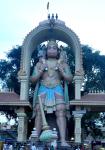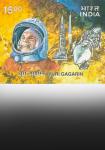That's because these iconic brands have been integral to British life as Tatas are back home in India. So, even as the world waits to find who wins them and how they are turned around, we thought we will take a peep into their rich pedigree.
A key point to understand is that Ford is selling these brands not because they are in their worst trouble ever, but simply because of Ford's overall crisis - it lost more than $12.6 billion in 2006 - is pushing CEO Alan Mulally to raise money to fulfill his declared ambition to restore the mass-market Ford business to health.
Ford is unwinding a 20-year initiative to boost profit by adding European luxury vehicles. Ford failed to reach a goal of generating a third of earnings from the European brands by 2006.
Jaguar Cars
Like many enterprises, life for Jaguar started small. In 1922, it began life as a manufacturer of motorcycle sidecars when two friends, William Walmsley and William Lyons, founded The Swallow Sidecar Company.
Soon, it began doing coachwork business, using the Austin 7 chassis to create the 1927 Austin Seven Swallow. Priced at £175, the Swallow, with its brightly coloured two-tone bodywork that imitated the style of more expensive cars of the time, proved popular. In 1934, the company changed its name to SS Cars Ltd.
After World War II, the company was renamed Jaguar Cars Ltd in 1945 due to the unfavourable connotations of the initials SS, which stood for Schutzstaffel, one of the major Nazi military organisations formed by Hitler.
Jaguar made its name in the 1950s with a series of elegantly-styled sports cars and luxury saloons. The company bought the Daimler car company (not Daimler-Benz), in 1960 from Birmingham Small Arms Company (BSA). From the late 1960s, Daimler was used as a brand name for Jaguar's luxurious saloons.
It merged with the British Motor Corporation, the Austin-Morris combine, to form British Motor Holdings in 1966. After merging with Leyland and Rover, it formed the British Leyland Motor Corporation in 1968. Financial difficulties in the 1970s led to effective nationalisation in 1975, and it came to be known as BL Ltd.
In 1984, Jaguar spun off as a separate company on the stock market. In 1990, Ford acquired Jaguar and made it part of the its new Premier Automotive Group, which included Aston Martin, Volvo Cars and, from 2000, Land Rover.
Since then, Ford has sunk over £10 billion into Jaguar and is yet to make money, although Jaguar cars improved their reliability and build quality under Ford. In 2007 survey by J D Power, Jaguar emerged as the number one car company in customer satisfaction
Ford paid £1.5 billion for Jaguar in 1989, £3.2 billion for Volvo's car operations in 1999, and £1.7 billion for Land Rover in 2000. Land Rover is profitable, and enjoys good margins (Volvo was making money until it turned unprofitable, which is why it has not been put on the block).
But Jaguar has been a problem child though many British experts believe some of its difficulties were made in Dearborn, Michigan.
In 2001, in a vain effort to push Jaguar volumes up, Ford launched the "baby Jag" X-type mid-size sedan, a car that many perceived to be a glammed-up Mondeo. It was given unpopular retro styling derived from the XJ limousine to be instantly recognisable as a Jag. It ultimately didn't sell as well as hoped.
But reports from the UK say that Jaguar has enjoyed a slow recovery and is on the verge of becoming profitable. But major questions over its production remain.
Production of Jaguars has fallen from almost 120,000 units in 2004 to just over 75,000 units last year. In global terms, despite its fame, Jaguar is a minnow, smaller than Saab or Alfa Romeo.
Part of the answer to Jaguar's problems, say British experts, lies in rationalising production, a process which has started under Ford.
Jaguars and Land Rovers (and Volvos and Fords) share many components, from the engines down. Keeping them together makes sense from an engineering as well as a business point of view.
So, irrespective of who the next owners of Jaguar and Land Rover are, they will continue to buy considerable quantities of material from Ford, and may remain reliant on it for the future development of new models.
Land Rovers
Land Rovers have often been featured in many films like The Gods Must Be Crazy, The Living Daylights and Mission: Impossible III. The brand enjoys cult status amongst enthusiasts, and there are hundreds of Land Rover clubs in the UK. In India, you could still find the old warhorse being used for commuting by locals in hilly areas like, between Darjeeling and Sikkim, and within Sikkim.
Originally, the term Land Rover referred to a specific vehicle, an all-terrain utility vehicle launched in 1948 but was later used as a brand for four-wheel drive vehicles. Based in Gaydon, England, Land Rover has seen several owners, including British Leyland, British Aerospace and BMW.
The first Land Rover was designed in 1947 in the UK by Maurice Wilks, chief designer at the British car company Rover. It is said that he was inspired by an American World War II Jeep that he used one summer at his holiday home in Wales.
The first prototype was built on a Jeep chassis. A distinctive feature is their bodies, constructed of a lightweight rustproof proprietary alloy of aluminium and magnesium called Birmabright. This material was used owing to post-war steel shortages and a plentiful supply of post-war aircraft aluminium.
But since the 1970s, in remote areas of Africa, South America, Asia and Australia, the somewhat similar Nissan Patrol and Mitsubishi Pajero have overtaken the Land Rover as the utility 4x4 of choice, partly because of better support network and reputation for reliability. The workhorse Toyota models tend to have larger engines than the comparable Land Rover models.
Land Rovers are manufactured at the Solihull plant, near Birmingham, while the production of the "Freelander 2" has moved to the Jaguar factory at Halewood near Liverpool. Defender models are assembled under licence in many locations worldwide, including Brazil and Turkey.
The Land Rover is used by military forces throughout the world. However, it is increasingly being supplemented and replaced, by larger vehicles.
This is mainly because combat vehicles today are required to carry much more equipment (weaponry), communications equipment and armour.
Though they are considered the safest vehicles on British roads, Land Rovers fare poorly on quality and reliability - they stood second-last in a 2007 US car reliability survey.
This is partly due its manufacturing methods. The Defender is still largely hand-built, with aluminium body panels mounted on a steel chassis. This makes it very hard for the vehicle to have the same rigidity and inter-panel sealing as is found on modern vehicles.
The other problem is that the Land Rover still makes heavy use of the British Leyland "parts bin" on its older models (the Defender and Freelander). This, and its parts-sharing scheme is often cited as the cause of many malfunctions. It now appears that Ford is attempting to address the Land Rover quality issues
Despite the recent drops in quality, more than 75 per cent of all Land Rovers produced since 1955 are still on the road. The simplicity of build and cross compatibility of parts with many earlier models, together with the enthusiasm of many owners, has ensured many vehicles have stayed on the road.







 © 2025
© 2025